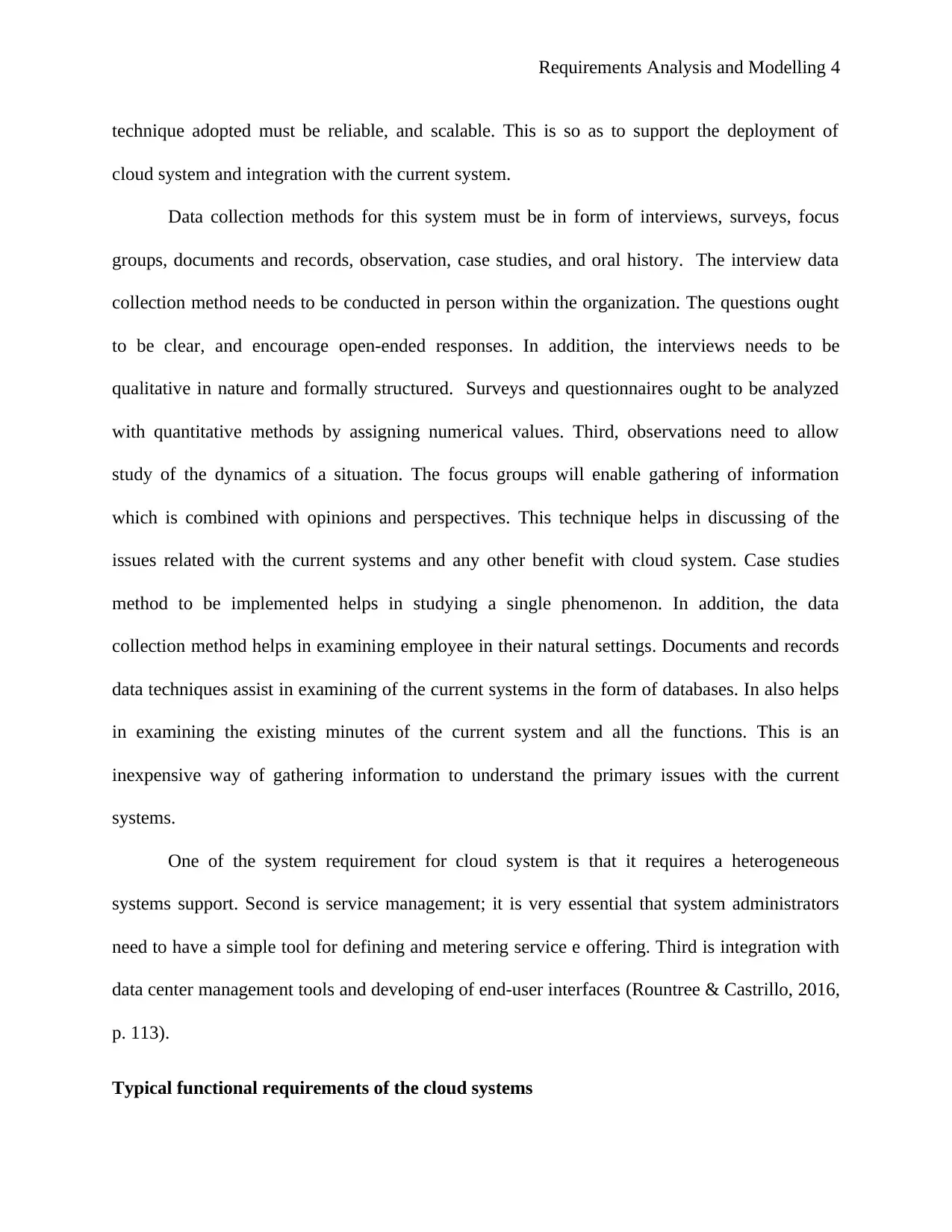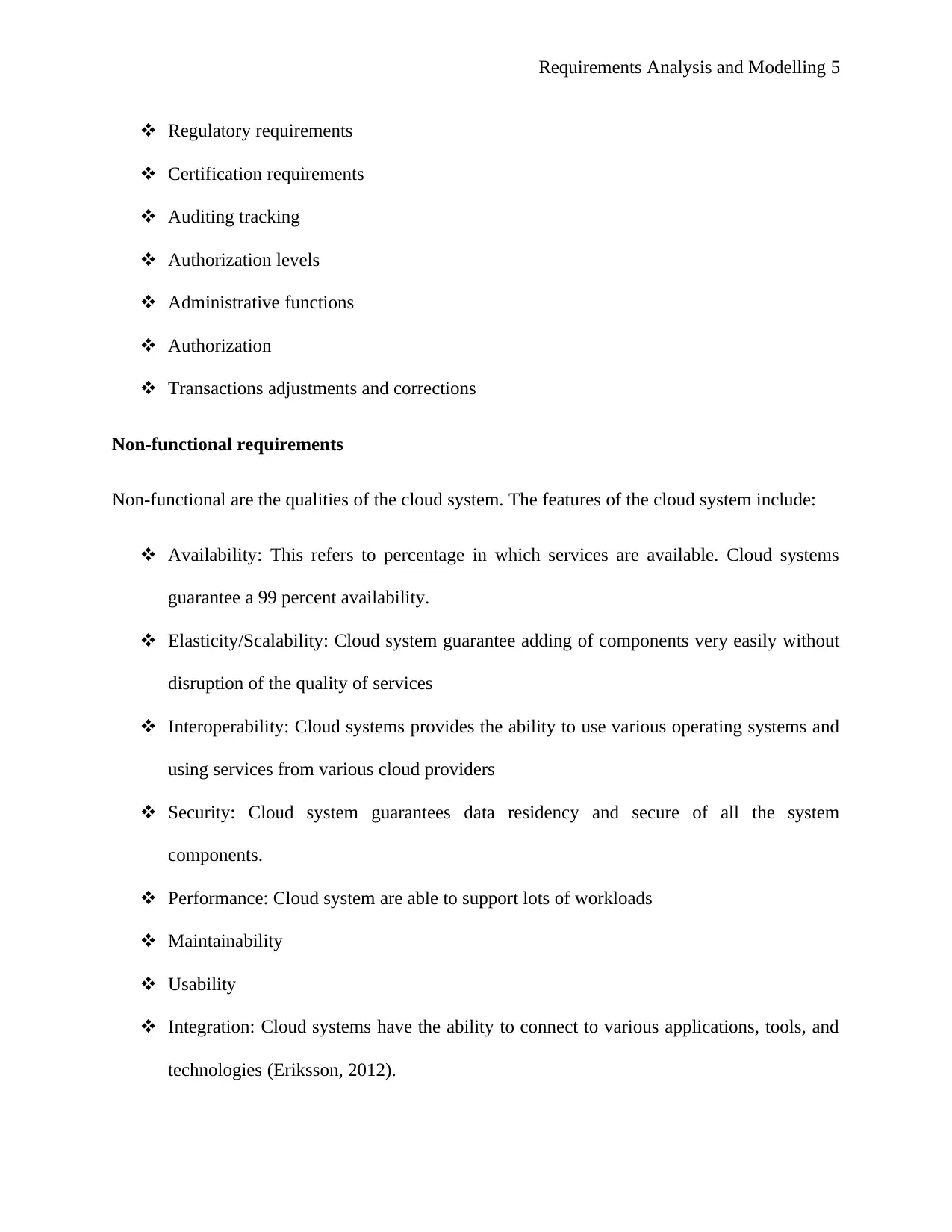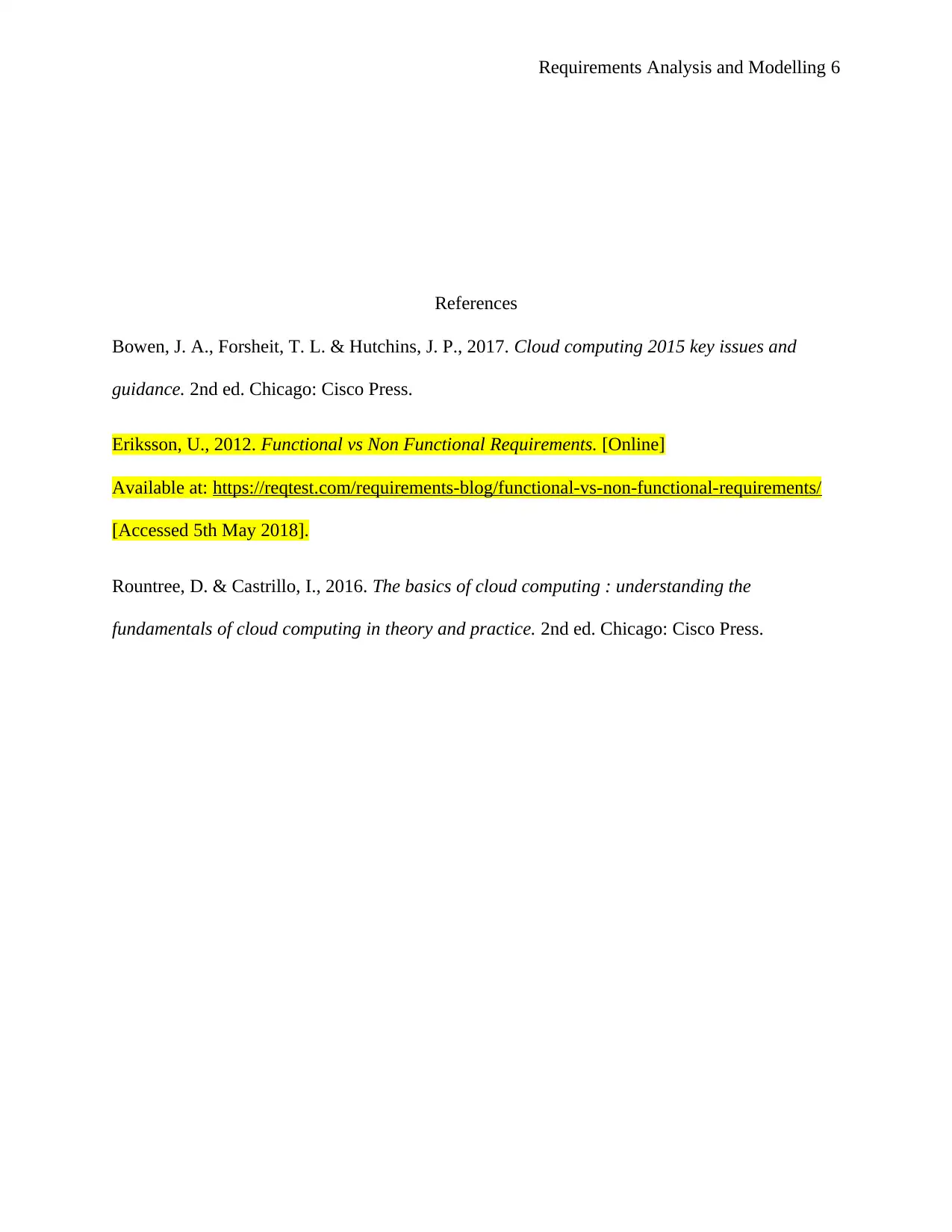INF20003: Requirements Analysis and Modelling Report - Cloud Systems
VerifiedAdded on 2023/03/21
|6
|1191
|22
Report
AI Summary
This report presents a comprehensive requirements analysis and modelling for a cloud system. It begins by identifying problems with existing systems, such as frequent disturbances, lack of mobility and collaboration, and inflexibility, proposing cloud systems as a solution. The report outlines the scope and system requirements, emphasizing the need for secure, manageable, reliable, and scalable data collection methods, including interviews, surveys, and case studies. It details both functional requirements (regulatory, certification, auditing, authorization, administrative functions, transactions) and non-functional requirements (availability, elasticity, interoperability, security, performance, maintainability, usability, and integration) for the proposed cloud system. The report concludes by referencing key sources that support the analysis.

Requirements Analysis and Modelling 1
REQUIREMENTS ANALYSIS AND MODELLING
By (Name)
(Course Title)
(Tutor’s Name)
(University Name)
(City)
(Date)
REQUIREMENTS ANALYSIS AND MODELLING
By (Name)
(Course Title)
(Tutor’s Name)
(University Name)
(City)
(Date)
Paraphrase This Document
Need a fresh take? Get an instant paraphrase of this document with our AI Paraphraser

Requirements Analysis and Modelling 2
Problem identification
The recent survey by Intel has indicated that over 93 percent of organizations have not
tapped into the power of cloud. These organizations do not have a clear concept of the value that
cloud system hold. Some of the issues faced with the current system are;
Frequent disturbances: The current systems are being faced by power outages, general
network issues, and hardware problems. In addition, installation of software updates
causes downtime.
Require daily technical support
Lack of mobility: The current system requires the users of the system to work within their
offices.
Lack of collaboration: The current systems do not support file sharing applications to
collaborate effectively. In addition, it is very difficult on the same task by the employees
as they are limited to their local workspace.
Architecture: The current system is not able to take advantage of the new services like
analytics and artificial intelligence, and the possibility for secure collaboration which are
outside the organization premises.
Lack of flexibility: The current system do not allow scaling up of the organizations. In
addition, the systems do not allow integration of applications like CRM and ERP
(Bowen, et al., 2017, p. 68).
These issues can be categorized into three:
Keeping advantage of the current upcoming technologies
By implementing cloud systems, organizations are able to take advantage of merits that
comes with cloud computing such as working from home thus increasing employee
Problem identification
The recent survey by Intel has indicated that over 93 percent of organizations have not
tapped into the power of cloud. These organizations do not have a clear concept of the value that
cloud system hold. Some of the issues faced with the current system are;
Frequent disturbances: The current systems are being faced by power outages, general
network issues, and hardware problems. In addition, installation of software updates
causes downtime.
Require daily technical support
Lack of mobility: The current system requires the users of the system to work within their
offices.
Lack of collaboration: The current systems do not support file sharing applications to
collaborate effectively. In addition, it is very difficult on the same task by the employees
as they are limited to their local workspace.
Architecture: The current system is not able to take advantage of the new services like
analytics and artificial intelligence, and the possibility for secure collaboration which are
outside the organization premises.
Lack of flexibility: The current system do not allow scaling up of the organizations. In
addition, the systems do not allow integration of applications like CRM and ERP
(Bowen, et al., 2017, p. 68).
These issues can be categorized into three:
Keeping advantage of the current upcoming technologies
By implementing cloud systems, organizations are able to take advantage of merits that
comes with cloud computing such as working from home thus increasing employee

Requirements Analysis and Modelling 3
productivity. The employees are able to use applications such as Office 365 for data entry
and perform other functions.
Lack of overall organization improvement, customer satisfaction, and increase of
employee productivity
Increased security: storing information on the current system, an organization might have
their systems affected by a natural disaster. Also, hosting systems on cloud systems is a
smart safeguard in times of emergency.
Other issues to solved by cloud systems
One of the issues to be solved by cloud system is that they are not issue on where to host
their sensitive data, cloud system is one great way of minimizing uncertainty. Second, cloud
system have advanced greatly and is currently more secure and reliable of the current reliable
than traditional on premise solutions.
Scope and systems requirements
Cloud system is an improvement of the existing system. The system will on-demand
delivery of service; it will also allow an improved customer experience. In addition, it will take
advantage of the upcoming technologies such as office 365, and analytics. Also cloud systems
takes advantage of low-cost computing technology with a wide and specialized connections to
spread data-processing chores across them. In addition, the systems takes advantage of
virtualization techniques to maximize the power of cloud computing. One can expand services as
organizations needs change.
To come up the cloud system, the data collection method adopted must be secure; the
method must guarantee confidentiality and integrity. Second, the technique adopted must be
manageable and it must provide control over the myriad of computing devices. Third, the
productivity. The employees are able to use applications such as Office 365 for data entry
and perform other functions.
Lack of overall organization improvement, customer satisfaction, and increase of
employee productivity
Increased security: storing information on the current system, an organization might have
their systems affected by a natural disaster. Also, hosting systems on cloud systems is a
smart safeguard in times of emergency.
Other issues to solved by cloud systems
One of the issues to be solved by cloud system is that they are not issue on where to host
their sensitive data, cloud system is one great way of minimizing uncertainty. Second, cloud
system have advanced greatly and is currently more secure and reliable of the current reliable
than traditional on premise solutions.
Scope and systems requirements
Cloud system is an improvement of the existing system. The system will on-demand
delivery of service; it will also allow an improved customer experience. In addition, it will take
advantage of the upcoming technologies such as office 365, and analytics. Also cloud systems
takes advantage of low-cost computing technology with a wide and specialized connections to
spread data-processing chores across them. In addition, the systems takes advantage of
virtualization techniques to maximize the power of cloud computing. One can expand services as
organizations needs change.
To come up the cloud system, the data collection method adopted must be secure; the
method must guarantee confidentiality and integrity. Second, the technique adopted must be
manageable and it must provide control over the myriad of computing devices. Third, the
⊘ This is a preview!⊘
Do you want full access?
Subscribe today to unlock all pages.

Trusted by 1+ million students worldwide

Requirements Analysis and Modelling 4
technique adopted must be reliable, and scalable. This is so as to support the deployment of
cloud system and integration with the current system.
Data collection methods for this system must be in form of interviews, surveys, focus
groups, documents and records, observation, case studies, and oral history. The interview data
collection method needs to be conducted in person within the organization. The questions ought
to be clear, and encourage open-ended responses. In addition, the interviews needs to be
qualitative in nature and formally structured. Surveys and questionnaires ought to be analyzed
with quantitative methods by assigning numerical values. Third, observations need to allow
study of the dynamics of a situation. The focus groups will enable gathering of information
which is combined with opinions and perspectives. This technique helps in discussing of the
issues related with the current systems and any other benefit with cloud system. Case studies
method to be implemented helps in studying a single phenomenon. In addition, the data
collection method helps in examining employee in their natural settings. Documents and records
data techniques assist in examining of the current systems in the form of databases. In also helps
in examining the existing minutes of the current system and all the functions. This is an
inexpensive way of gathering information to understand the primary issues with the current
systems.
One of the system requirement for cloud system is that it requires a heterogeneous
systems support. Second is service management; it is very essential that system administrators
need to have a simple tool for defining and metering service e offering. Third is integration with
data center management tools and developing of end-user interfaces (Rountree & Castrillo, 2016,
p. 113).
Typical functional requirements of the cloud systems
technique adopted must be reliable, and scalable. This is so as to support the deployment of
cloud system and integration with the current system.
Data collection methods for this system must be in form of interviews, surveys, focus
groups, documents and records, observation, case studies, and oral history. The interview data
collection method needs to be conducted in person within the organization. The questions ought
to be clear, and encourage open-ended responses. In addition, the interviews needs to be
qualitative in nature and formally structured. Surveys and questionnaires ought to be analyzed
with quantitative methods by assigning numerical values. Third, observations need to allow
study of the dynamics of a situation. The focus groups will enable gathering of information
which is combined with opinions and perspectives. This technique helps in discussing of the
issues related with the current systems and any other benefit with cloud system. Case studies
method to be implemented helps in studying a single phenomenon. In addition, the data
collection method helps in examining employee in their natural settings. Documents and records
data techniques assist in examining of the current systems in the form of databases. In also helps
in examining the existing minutes of the current system and all the functions. This is an
inexpensive way of gathering information to understand the primary issues with the current
systems.
One of the system requirement for cloud system is that it requires a heterogeneous
systems support. Second is service management; it is very essential that system administrators
need to have a simple tool for defining and metering service e offering. Third is integration with
data center management tools and developing of end-user interfaces (Rountree & Castrillo, 2016,
p. 113).
Typical functional requirements of the cloud systems
Paraphrase This Document
Need a fresh take? Get an instant paraphrase of this document with our AI Paraphraser

Requirements Analysis and Modelling 5
Regulatory requirements
Certification requirements
Auditing tracking
Authorization levels
Administrative functions
Authorization
Transactions adjustments and corrections
Non-functional requirements
Non-functional are the qualities of the cloud system. The features of the cloud system include:
Availability: This refers to percentage in which services are available. Cloud systems
guarantee a 99 percent availability.
Elasticity/Scalability: Cloud system guarantee adding of components very easily without
disruption of the quality of services
Interoperability: Cloud systems provides the ability to use various operating systems and
using services from various cloud providers
Security: Cloud system guarantees data residency and secure of all the system
components.
Performance: Cloud system are able to support lots of workloads
Maintainability
Usability
Integration: Cloud systems have the ability to connect to various applications, tools, and
technologies (Eriksson, 2012).
Regulatory requirements
Certification requirements
Auditing tracking
Authorization levels
Administrative functions
Authorization
Transactions adjustments and corrections
Non-functional requirements
Non-functional are the qualities of the cloud system. The features of the cloud system include:
Availability: This refers to percentage in which services are available. Cloud systems
guarantee a 99 percent availability.
Elasticity/Scalability: Cloud system guarantee adding of components very easily without
disruption of the quality of services
Interoperability: Cloud systems provides the ability to use various operating systems and
using services from various cloud providers
Security: Cloud system guarantees data residency and secure of all the system
components.
Performance: Cloud system are able to support lots of workloads
Maintainability
Usability
Integration: Cloud systems have the ability to connect to various applications, tools, and
technologies (Eriksson, 2012).

Requirements Analysis and Modelling 6
References
Bowen, J. A., Forsheit, T. L. & Hutchins, J. P., 2017. Cloud computing 2015 key issues and
guidance. 2nd ed. Chicago: Cisco Press.
Eriksson, U., 2012. Functional vs Non Functional Requirements. [Online]
Available at: https://reqtest.com/requirements-blog/functional-vs-non-functional-requirements/
[Accessed 5th May 2018].
Rountree, D. & Castrillo, I., 2016. The basics of cloud computing : understanding the
fundamentals of cloud computing in theory and practice. 2nd ed. Chicago: Cisco Press.
References
Bowen, J. A., Forsheit, T. L. & Hutchins, J. P., 2017. Cloud computing 2015 key issues and
guidance. 2nd ed. Chicago: Cisco Press.
Eriksson, U., 2012. Functional vs Non Functional Requirements. [Online]
Available at: https://reqtest.com/requirements-blog/functional-vs-non-functional-requirements/
[Accessed 5th May 2018].
Rountree, D. & Castrillo, I., 2016. The basics of cloud computing : understanding the
fundamentals of cloud computing in theory and practice. 2nd ed. Chicago: Cisco Press.
⊘ This is a preview!⊘
Do you want full access?
Subscribe today to unlock all pages.

Trusted by 1+ million students worldwide
1 out of 6
Related Documents
Your All-in-One AI-Powered Toolkit for Academic Success.
+13062052269
info@desklib.com
Available 24*7 on WhatsApp / Email
![[object Object]](/_next/static/media/star-bottom.7253800d.svg)
Unlock your academic potential
Copyright © 2020–2025 A2Z Services. All Rights Reserved. Developed and managed by ZUCOL.




